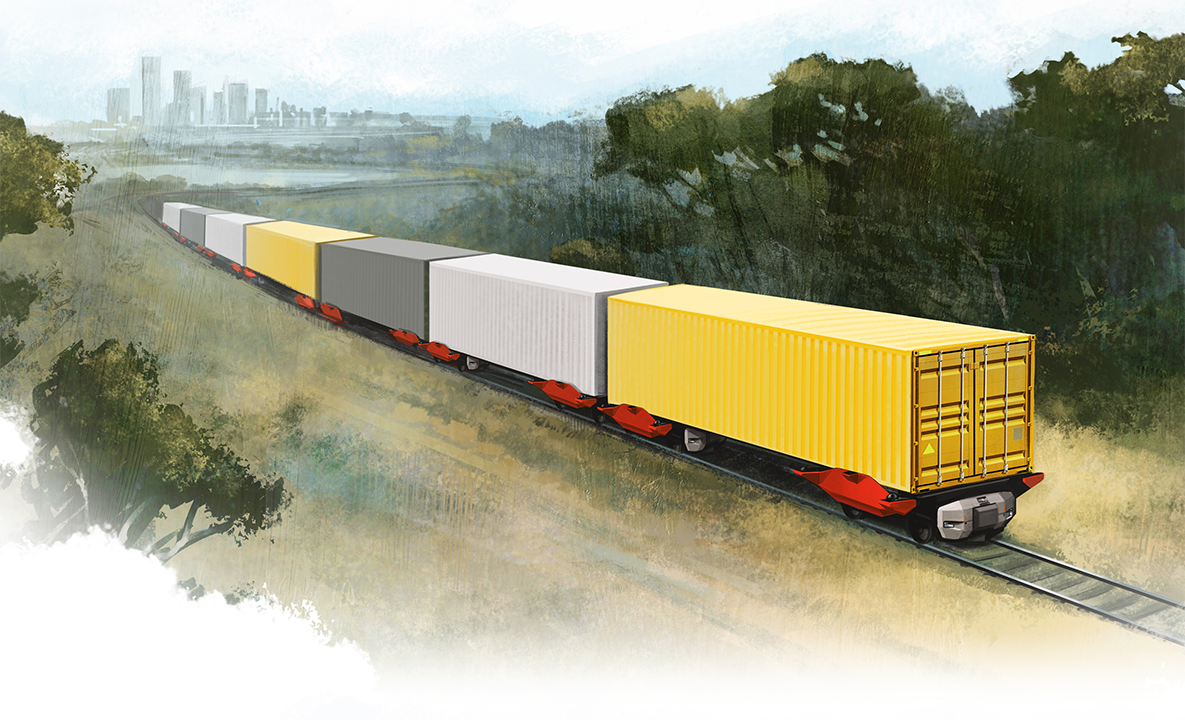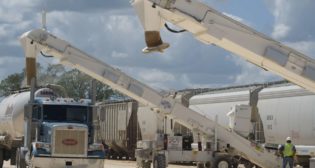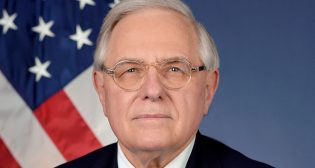
Watch: Parallel Systems Debuts 2nd-Gen Autonomous Battery-Electric Freight Car
Written by Marybeth Luczak, Executive Editor
Parallel Systems plans to start “platoon demonstrations” of second-generation autonomous battery-electric railcars later this year. According to the company, each railcar is individually powered and can “form platoons of up to 50 cars to reduce energy consumption and efficiently use rail network capacity” or split off to multiple destinations while en route. (Rendering Courtesy of Parallel Systems)
Los Angeles, Calif.-based Parallel Systems on Sept. 12 introduced its second-generation autonomous battery-electric freight car, which it plans to pilot test on existing U.S. and international rail networks.
More flexible than traditional trains, according to Parallel Systems, the railcars are designed to transport standard shipping containers as a single- or double-stacked load in short-haul freight operations, and “enable more responsive service and a wider range of routes” using the current rail network. Each railcar is individually powered and can “form platoons of up to 50 cars to reduce energy consumption and efficiently use rail network capacity,” or split off to multiple destinations while en route, the company said. The platooning is fully automated so the railcars don’t need to couple or uncouple, it noted. “They simply move close to each other and then initiate contact through bumpers to form platoons,” Parallel explained. “Once contact is made, each vehicle maintains a set force with the one in front by regulating tractive effort. The small air gap and pushing action through railcar bumpers reduces overall aerodynamic drag of the platoon, improving energy efficiency.” Development of the railcars was first announced in January 2022.
With its second-generation railcar, Parallel is now conducting “critical testing to verify the system’s ability to use the general rail network,” reported the company, which said it is developing “tools and software so railroad customers can operate Parallel vehicles from their existing dispatching and train control systems.”
Parallel Systems said it has produced three second-gen railcars so far; three additional railcars are in production and more are expected to follow. They are being built to the following specifications:
- Propulsion system: Battery-electric traction motor powertrain.
- Autonomous system: Fully autonomous, with bi-directional camera-based perception system.
- Payload capacity: Up to 70,000 pounds / 58,000 kilograms (with a single stack container).
They will offer an up to 500-mile range on less than one hour of charge time, according to the company.
The second-gen railcar is said to include both autonomous and remote-operation features. “While initial pilot tests will operate under supervision at all times, the autonomous system will be installed, learning and improving as Parallel further develops its autonomous capability,” the company said.
The second-gen railcar’s most notable visual update from the previous design, Parallel said, “is a spanning structure that connects each end of the railcar to accommodate a standard-sized shipping container.” Parallel said it plans to offer “a portfolio of solutions and this allows the company to test the new architecture that is well-suited for international markets and is more cost effective.”
Since November 2022, the railcars have been undergoing control, telemetry, traction, brake and dynamics testing at Parallel’s Southern California test track. Track-worthiness testing is slated to be conducted in 2024 with MxV Rail, a wholly owned subsidiary of the Association of American Railroads.
Parallel said that it is now working customers to bring the railcars to existing rail networks in the U.S. and internationally. Genesee & Wyoming Inc. (G&W) subsidiaries Georgia Central Railway, L.P. (GC) and Heart of Georgia Railroad, Inc. (HOG) on Aug. 10 filed a petition with the Federal Railroad Administration (FRA) to pilot Parallel Systems railcars on portions of their rail lines. If approved, the railroads said a multi-phased pilot would begin next year and be overseen by the FRA, G&W and Parallel Systems, allowing G&W and Parallel Systems to “demonstrate the technology in a field setting while using carefully developed protocols to ensure the pilot is operated in a safe, controlled manner.”
Parallel reported Sept. 12 that it expects to begin platoon demonstrations later this year.
“Testing this vehicle generation and supporting systems is a critical step in our product development to inform our commercial product,” Parallel Systems Co-founder and CEO Matt Soule said. “With less than 3% of the 143,000 miles of U.S. railway occupied by active trains at any given moment, there’s immense opportunity to shift freight from the overburdened trucking industry to rail. In addition to addressing the truck driver shortage, converting 100,000 trucking miles to Parallel’s rail zero-emissions vehicles would eliminate up to 175 tons of carbon dioxide from the atmosphere.”
In February 2022, Parallel Systems, founded by three former SpaceX engineers, was awarded a $4.4 million U.S. Department of Energy (DOE) grant to test its autonomous, battery-electric powered railcar technology. The award followed the company’s Jan. 19, 2022, report stating that it had raised $49.55 million in Series A funds to help build a fleet of new railcars for short-haul freight operations, continue testing and grow the company.
![“This record growth [in fiscal year 2024’s third quarter] is a direct result of our innovative logistic solutions during supply chain disruptions as shippers focus on diversifying their trade lanes,” Port NOLA President and CEO and New Orleans Public Belt (NOPB) CEO Brandy D. Christian said during a May 2 announcement (Port NOLA Photograph)](https://www.railwayage.com/wp-content/uploads/2024/05/portnola-315x168.png)


